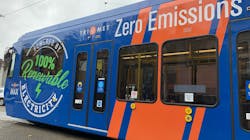TriMet reduces carbon emissions by more than 25 percent with move to all renewable electricity
TriMet has moved to all renewable electricity to power the MAX light-rail system and all TriMet-owned facilities, as well as its electric buses.
“At TriMet, we’re part of the solution to climate change, reducing the region’s carbon emissions through providing quality transit service and by taking important steps, such as supporting 100 percent renewable energy, that reduce our own carbon footprint,” said TriMet interim General Manager Sam Desue, Jr. “It’s a win-win for our environment.”
TriMet says this immediately reduces its carbon emissions by more than 25 percent. By supporting renewable energy, TriMet says it expects to avoid more than 54 million pounds of greenhouse gas emissions within a year. That’s the equivalent of taking more than 5,300 cars off the road.
“To achieve our climate goals, it will take all of us working together,” said Portland General Electric President and CEO Maria Pope. “TriMet’s transition to renewable power for their facilities, the MAX system and electric buses is just the kind of leadership and partnership required to create the clean energy future Oregonians want.”
“Innovation around transportation electrification is picking up speed across Oregon,” said Pacific Power Vice President of Regulation, Customer and Community Solutions Etta Lockey. “Together, we are building infrastructure and programs that help cut vehicle emissions while supporting carbon reduction goals set by TriMet and other forward-thinking community partners. This work is giving communities across the state greater access to electric transportation.”
Steps to a cleaner future
This data from 2019 shows “consumed electricity” at 23 percent of TriMet’s CO2e emissions. Since that time, TriMet has deployed more battery-electric buses into service and added lighting at some facilities/stations. With those changes, “consumed electricity” became responsible for more than 25 percent of the agency’s CO2e emissions.
In 2020, TriMet notes it took a deep look at the sources of its greenhouse gas emissions. TriMet found that the electricity used accounted for the agency’s second largest source of carbon dioxide emissions – only behind the diesel bus fleet. By moving to PGE’s Green Future and Pacific Power’s Blue Sky programs, TriMet anticipates paying an additional four percent more to reduce its carbon emissions by more than a quarter.
Transitioning to zero-emissions bus fleet
TriMet has already committed to transition from a diesel bus fleet to a zero-emissions bus fleet by 2040. Transitioning away from diesel will take time as electric and other alternative fuel source technology for buses is still evolving. TriMet says it had some success with the first fleet of five short-range battery-electric buses launched in 2019, but challenges as well. The second fleet of five long-range electric buses should roll out this year. While TriMet continues to pursue zero-emission buses and make the transition away from diesel, it is looking at other near-term opportunities to make a difference such as the move to renewable electricity.



